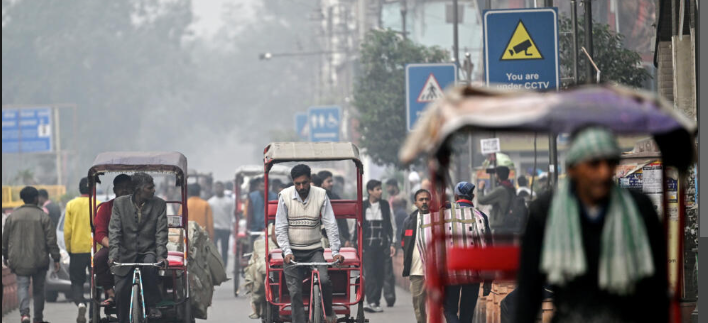South Asia Air Pollution Fell in 2022, but Remains a Major Killer: –
South Asia, a region known for its dense population and rapid urbanization, has made significant strides in reducing air pollution levels in recent years. According to a recent report, air pollution in South Asia saw a notable decline in 2022, marking a positive trend in the region’s ongoing battle against environmental degradation. However, despite this progress, air pollution continues to pose a severe health threat and remains one of the leading causes of premature death in the region. This article delves into the details of the report, examines the factors contributing to the reduction in pollution levels, and explores the persistent challenges and implications for public health and policy.
Overview of Air Pollution in South Asia
South Asia Air Pollution comprising countries such as India, Pakistan, Bangladesh, Nepal, Bhutan, and Sri Lanka, has long struggled with high levels of air pollution. The region’s air quality has been a major concern due to factors such as industrial emissions, vehicular exhaust, agricultural practices, and geographical conditions that exacerbate pollution.  for more information click on this link
for more information click on this link
Key Pollutants
- Particulate Matter (PM2.5 and PM10): Fine particulate matter (PM2.5) and coarse particulate matter (PM10) are the primary pollutants in South Asia. PM2.5 particles are particularly dangerous because they can penetrate deep into the lungs and enter the bloodstream, causing severe health issues.
- Nitrogen Dioxide (NO2): NO2 is another significant pollutant, primarily emitted from vehicles and industrial processes. It contributes to the formation of ground-level ozone and can exacerbate respiratory problems.
- Sulfur Dioxide (SO2): SO2 is released from burning fossil fuels and industrial activities. It can lead to the formation of acid rain and contribute to respiratory illnesses.
- Carbon Monoxide (CO): CO is produced by incomplete combustion of fossil fuels and can impair the ability of blood to carry oxygen, affecting cardiovascular health.
Findings of the 2022 Report
The 2022 report on air pollution in South Asia highlights a reduction in pollution levels compared to previous years. The report, compiled by environmental organizations and research institutions, provides a comprehensive analysis of air quality trends and their implications for public health.  for more information click on this link
for more information click on this link
Key Findings
- Reduction in PM2.5 Levels: The report indicates a significant decline in average PM2.5 levels across South Asia Air Pollution .This reduction is attributed to various factors, including stricter regulations, improved technology, and temporary reductions in industrial activity during the COVID-19 pandemic.
- Improved Air Quality in Major Cities: Several major cities in South Asia, such as Delhi, Mumbai, and Dhaka, have experienced improvements in air quality. Initiatives such as cleaner fuels, better public transportation, and pollution control measures have contributed to these positive changes.
- Regional Variations: While there has been overall progress, the report notes regional variations in air quality improvements. Urban areas with high population densities and industrial activities still experience elevated pollution levels compared to rural areas.
- Ongoing Health Risks: Despite the improvements, air pollution remains a major health risk in South Asia. The report underscores that the reduction in pollution levels has not been sufficient to eliminate the health impacts associated with poor air quality.
Factors Contributing to the Reduction in Air Pollution
Several factors have contributed to the observed decline in air pollution levels in South Asia. These include policy interventions, technological advancements, and shifts in industrial practices.
Policy Interventions
- Stricter Regulations: Governments in South Asia have implemented stricter environmental regulations aimed at reducing emissions from vehicles and industrial sources. Policies such as vehicle emission standards, industrial pollution control measures, and restrictions on the use of certain fuels have played a role in improving air quality.
- Clean Air Initiatives: Various clean air initiatives and programs have been launched to address pollution sources. For example, the Indian government’s National Clean Air Programme (NCAP) and similar programs in other countries focus on reducing pollution and enhancing monitoring and enforcement.
- Public Awareness Campaigns: Increasing public awareness about the health impacts of air pollution and promoting behavioral changes have contributed to reduced pollution levels. Campaigns encouraging the use of public transportation, reduction of open burning, and adoption of cleaner technologies have had a positive impact.
Technological Advancements
- Cleaner Technologies: Advances in technology have led to the development and adoption of cleaner industrial processes and fuels. Technologies such as scrubbers, filters, and cleaner-burning fuels have helped reduce emissions from industrial sources and power plants.
- Electric Vehicles: The adoption of electric vehicles (EVs) has contributed to reduced vehicular emissions. Several South Asian countries are promoting EVs as part of their strategy to improve air quality and reduce dependence on fossil fuels.
Shifts in Industrial Practices
- Reduced Industrial Activity: The COVID-19 pandemic led to temporary reductions in industrial activity, resulting in a short-term improvement in air quality. While this was a temporary effect, it highlighted the impact of industrial emissions on South Asia Air Pollution levels.
- Shift to Renewable Energy: There has been a gradual shift towards renewable energy sources, such as solar and wind power, in South Asia. This transition helps reduce reliance on coal and other fossil fuels, contributing to lower pollution levels.
Persistent Challenges and Health Implications
Despite the progress made in reducing air pollution, South Asia continues to face significant challenges. The health implications of ongoing pollution remain severe, with air pollution being a major cause of premature death and disease in the region.
Health Impacts
- Respiratory and Cardiovascular Diseases: Exposure to high levels of air pollution is linked to respiratory and cardiovascular diseases. Conditions such as asthma, chronic obstructive pulmonary disease (COPD),South Asia Air Pollution and heart disease are prevalent among populations exposed to poor air quality.
- Premature Mortality: The report highlights that air pollution continues to be a leading cause of premature mortality in South Asia. The health burden of pollution-related diseases remains substantial, particularly among vulnerable groups such as children, the elderly, and individuals with pre-existing health conditions.
- Impact on Children’s Health: Children are particularly vulnerable to the effects of air pollution, which can lead to developmental issues, reduced lung function, and increased susceptibility to respiratory infections.
Socioeconomic Implications
- Economic Costs: The health impacts of air pollution have significant economic costs, including increased healthcare expenditures and loss of productivity. Addressing air pollution-related health issues requires substantial investments in healthcare infrastructure and resources.
- Disparities in Exposure: There are disparities in South Asia Air Pollution exposure, with marginalized communities often facing higher levels of pollution. Socioeconomic factors contribute to unequal exposure and health outcomes, highlighting the need for targeted interventions to address these disparities.
 for more information click on this link
for more information click on this link
Policy Recommendations and Future Directions
To build on the progress made and address the ongoing challenges, several policy recommendations and future directions are proposed:
Strengthening Regulatory Frameworks
- Enhanced Enforcement: Governments need to strengthen the enforcement of environmental regulations and ensure compliance by industries and other polluters. This includes regular monitoring and penalties for violations.
- Expansion of Clean Air Programs: Expanding and enhancing clean air programs and initiatives can help address remaining South Asia Air Pollution sources and improve air quality further.
Promoting Technological Innovations
- Investment in Research: Increased investment in research and development of clean technologies can drive further improvements in pollution control and reduction.
- Incentives for Clean Energy: Providing incentives for the adoption of renewable energy and cleaner technologies can accelerate the transition away from fossil fuels.
Addressing Health Impacts
- Public Health Interventions: Implementing public health interventions and programs to address pollution-related health issues can help mitigate the impact on affected populations.
- Health Education: Increasing public awareness and education about the health risks of air pollution and promoting preventive measures can improve community resilience.
Fostering Regional Cooperation
- Cross-Border Collaboration: Regional cooperation and collaboration among South Asia Air Pollution countries can enhance efforts to address transboundary air pollution and share best practices.
- Joint Initiatives: Joint initiatives and partnerships between governments, international organizations, and civil society can strengthen the collective response to air pollution challenges.
Conclusion
The 2022 report on air South Asia Air Pollution presents a mixed picture: while there has been a notable decline in pollution levels, air pollution remains a major health threat and a leading cause of premature death. The progress made in reducing pollution is encouraging, but the region must continue to address the persistent challenges and work towards further improvements.
By implementing effective policies, South Asia Air Pollution promoting technological innovations, and addressing the health impacts of South Asia Air Pollution can build on its successes and strive towards a cleaner and healthier environment for its population. The ongoing efforts to combat air pollution are crucial for ensuring sustainable development and enhancing the quality of life for millions of people across the region. ALSO READ:-Supreme Court Grants Bail to K. Kavitha in Excise Policy Cases: A Deep Dive into the Legal and Political Implications 2024




